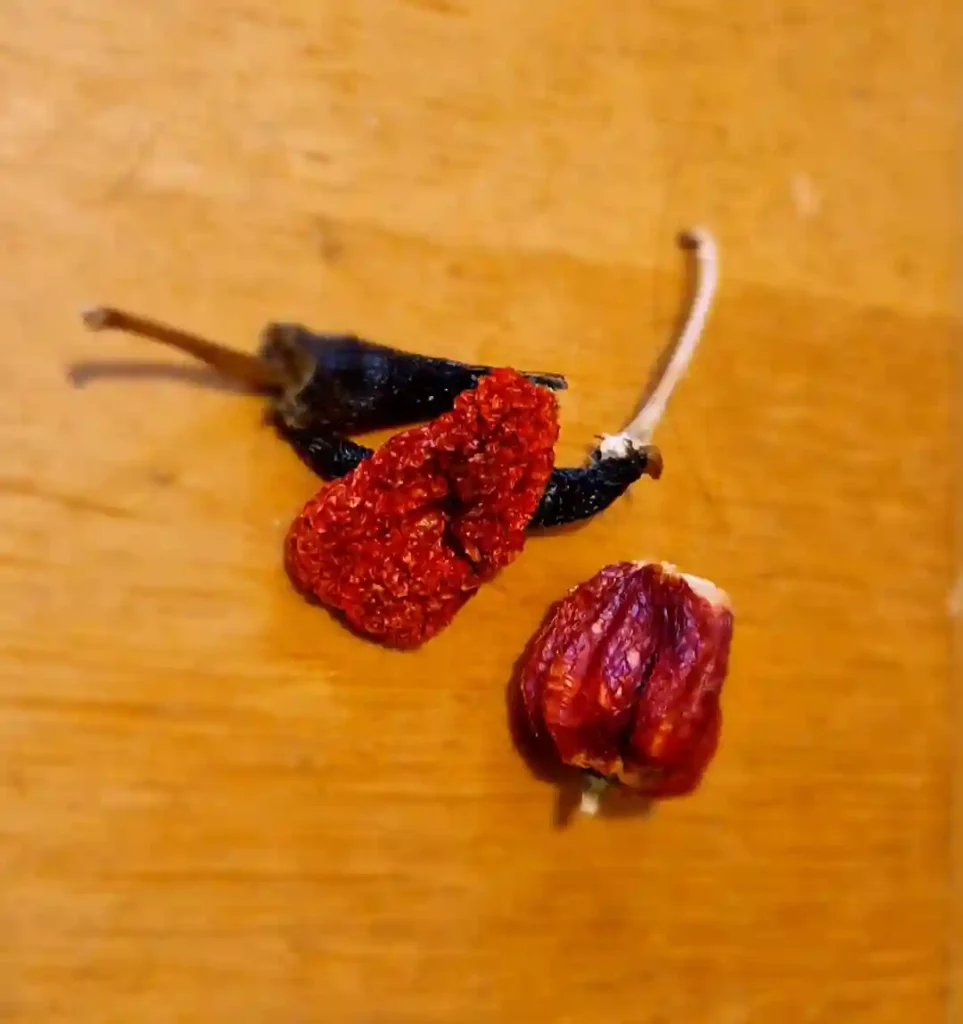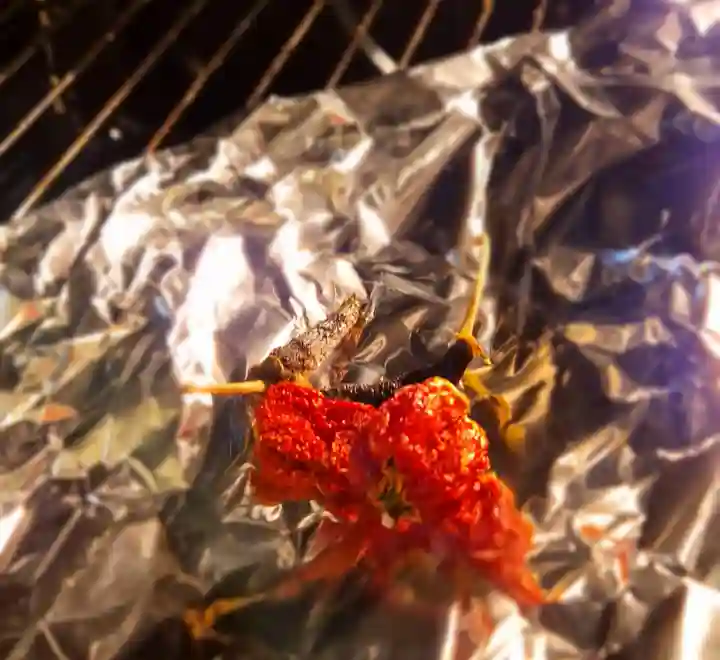What to Do with Extra Hot Peppers
What to do with extra hot peppers? It’s a question that many chili enthusiasts, including me, face as they wrap up the growing season. If you’re like me, you’ve had a bountiful harvest of peppers, ranging from the mildly spicy to the scorching hot. In a previous post, I discussed what to do with chili peppers in general and what to do with too many Jalapenos, but this time, I will focus on those extra-spicy chili peppers.
The season might be coming to a close for some, and it ended a month or two ago for others. You’ve cared for your plants, nurturing them to fruition. Whether you’ve got Poblanos, Trinidad Moruga Scorpion, Ghost Pepper, or even Carolina Reapers, there’s a common thread—what to do with all those ripe pods, especially the superhot ones?
In this post, I am here to inspire you. We’ll discuss using these spicy, burning ingredients in your cooking and provide some practical ideas and recipes.
For example, drying extra hot chili peppers is a good way to make the most of these fiery gems. It not only extends their shelf life but also offers some interesting advantages. When you dry these peppers, you can temper their intense heat, making them more versatile in various recipes. While the spiciness remains, it becomes a bit easier to control.
Outline
This post will explore six ways to use your spicy peppers, focusing on culinary possibilities. First, we’ll cover drying the pods for long-term use, touching upon various drying methods to preserve the flavor and how to store dried peppers.
Next, we’ll make homemade hot pepper powder, using dried extra hot peppers as a spice to elevate various dishes. Yummy!
I’ll touch upon infusing oils and vinegars with hot peppers, ensuring you handle them safely while creating flavorful infusions for your culinary creations.
Then, we’ll explore the technique of pickling extra hot peppers, another good preservation method that opens the door to diverse applications in your cooking.
After that, we’ll look at creating your own spicy sauces and condiments, allowing you to customize your creations based on the chili varieties you love.
To ensure you master cooking with extra hot peppers, I’ll provide essential tips for reducing heat if a dish becomes too spicy.
Lastly, I’ll address the importance of safely handling super hot chili peppers.
With these insights into what to do with hot peppers, you’ll be well-equipped to embrace the challenge of using the superhot ingredients to their fullest potential in your culinary adventures.
Table of Contents
- Outline
- What to do with Extra Hot Peppers
- 6. Cooking Tips for Extra Hot Peppers
- Conclusion: What to do with Hot Peppers
- Conclusion
What to do with Extra Hot Peppers
Here are six ways to use your super hot peppers.
1. Drying for Long-Term Use
Drying extra hot chili peppers is a fantastic way to make the most of these fiery gems. It not only extends their shelf life but also offers some interesting advantages. When you dry these peppers, you can temper their intense heat, making them vice versa.

Exploring Drying Methods: From Sun to Dehydrator
Now that you know why you should dry your extra hot peppers, let’s dive into the ‘how.’ There are a few methods to choose from:
- Sun Drying: A classic method that’s budget-friendly and environmentally sustainable. Lay your peppers out in the sun, and let the natural heat and airflow work magic. This technique requires patience, which can take several days to achieve the desired dryness.
- Oven Drying: If you’re looking for a quicker solution, your kitchen oven is a valuable ally. Please set it to a low temperature (usually around 150°F or 65°C), and place your peppers on a baking sheet. Check them regularly to avoid over-drying.

- Dehydrator: The most efficient and controlled method. Dehydrators allow you to set the exact temperature and humidity levels needed for optimal drying. They’re convenient if you have a large harvest to process.
Storing Dried Peppers: Extending Their Lifespan
Now that you know what to do with extra hot peppers, let’s talk about how to keep them in tip-top shape. To maintain their potency and flavor, it’s crucial to store them properly. Here’s what to do with hot peppers once they’re dried:
- Airtight Containers: Store dried peppers in airtight containers like glass jars or vacuum-sealed bags. This prevents moisture from creeping in and compromising their quality.
- Cool, Dark Place: Store your dried peppers in a cool, dark spot in your kitchen or pantry. Exposing them to direct sunlight or heat can cause flavor loss.
- Labeling: Remember to label your containers with the pepper type and drying date. This will prevent you from having unexpected encounters with super-hot peppers.
So, what to do with hot peppers? Drying them preserves their fiery essence and opens the door to a world of culinary possibilities. You’ll be able to enjoy your favorite spicy flavors all year round, whether you sprinkle them on your pizza or add them to your favorite hot sauce recipe.
2. Making Homemade Hot Pepper Powder
Now that you’ve successfully dried your extra hot chilis, the next step can be to transform them into a potent and versatile ingredient: hot pepper powder. Here’s what to do with dried hot peppers to create your fiery concoction.
Crafting Your Homemade Hot Pepper Powder
Grinding dried chili peppers into a flavorful powder is straightforward, but getting the heat level right requires some finesse. The key is to control the intensity, ensuring it suits your taste buds. Here’s how:
- Select Your Grinder: A good spice grinder or a sturdy blender can do the trick. The finer you can grind your peppers, the more evenly their heat will disperse in your dishes.
- Safety First: It’s essential to wear gloves while handling dried hot peppers to avoid skin and eye irritation. Additionally, ensure proper ventilation to avoid inhaling the chili dust, which can be quite potent.
- Adjust the Heat: To achieve the desired level of spiciness, blend a mix of milder and super-hot peppers. Experiment with different combinations until you find your perfect balance of heat.
Uses of Homemade Hot Pepper Powder
Now that you have your homemade hot pepper powder let’s explore the exciting array of culinary applications:
- Spicy Seasoning: Sprinkle it on roasted vegetables, grilled meats, or even a bowl of popcorn for a fiery kick.
- Flavorful Rubs: Mix it with herbs and spices to make a rub for barbecue or grilling.
- Savory Soups and Stews: Add depth and heat to your favorite soups and stews by incorporating a pinch of your homemade powder.
- Spice Up Dips and Salsas: Elevate the flavors of your dips, salsas, and marinades by infusing them with this potent powder.
Creating your hot pepper powder is not only rewarding, but it also lets you take control of the heat in your dishes. So, what to do with hot peppers has transformed into a compelling adventure where you call the shots, from the level of spiciness to the delicious recipes you can concoct. Prepare to spice up your culinary creations with homemade hot pepper powder.
3. Infusing Oils and Vinegars
One use for super hot peppers is to utilize them to infuse oil and vinegar.
Guide for Chili-Infused Oils and Vinegars
One of the most delightful ways to utilize your extra hot chilis is by infusing oils and vinegars with their fiery essence. Here’s a step-by-step guide on what to do with hot peppers for creating these flavor-packed infusions:
- Select Your Peppers: Choose your preferred chili peppers, whether you favor the searing heat of Habaneros or the milder touch of Jalapeños. A mix of varieties can create exciting flavor profiles.
- Clean and Slice: Wash the peppers thoroughly and slice them. Leave the seeds in for extra heat or remove them for a milder infusion.
- Heat and Infuse: Gently heat your chosen oil (olive, grapeseed, or any of your choice) or vinegar in a pan. Add the sliced peppers and let them simmer for a few minutes to release their flavors.
- Cool and Store: After infusing, let the mixture cool. Strain the pepper slices and transfer the flavored oil or vinegar to a glass bottle or container. Seal it tightly for future use.
Safety Precautions for Handling Extra Hot Chili Peppers
Infusing oils and vinegars with chili peppers is a rewarding endeavor, but it comes with its share of precautions:
- Wear Gloves: Handling hot peppers can irritate your skin and eyes. Always wear gloves when working with them.
- Ventilation: Ensure your workspace is well-ventilated to avoid inhaling chili fumes, which can be quite potent.
- Caution with Eyes: Avoid touching your face, especially your eyes, while working with hot peppers. Please wash your hands thoroughly after handling them.
Culinary Applications for Flavorful Infusions
Now that you have your chili-infused oils and vinegars, it’s time to get creative in the kitchen. Here are some delectable culinary applications:
- Dressings and Marinades: Create zesty salad dressings and marinades to enhance the flavors of your favorite dishes.
- Dipping Sauces: Serve chili-infused oils or vinegars as dipping sauces for bread, roasted vegetables, or seafood.
- Flavorful Sauteing: Use chili-infused oils to add depth to sautéed vegetables, meats, or seafood.
- Splendid Roasts: Drizzle your infused oils over roasts or grilled dishes for an extra flavor.
4. Pickling Extra Hot Peppers
Preserving Hot Peppers Through Pickling
One of the classic and delightful ways to extend the life of your extra hot peppers is by pickling them. This process preserves their fiery kick and introduces a tangy twist. Here’s how to do it:
- Select Your Peppers: Choose your preferred hot peppers – Carolina Reapers, Trinidad Scorpions, or any variety you adore.
- Prepare a Brine: Make a brine solution by mixing 475 ml (2 cups) water, 475 ml white vinegar, and two tablespoons (30 ml) salt. You can adjust the salt to your preference.
- Wash and Slice: Thoroughly wash your peppers and slice them. Keep the seeds if you want the extra heat, or remove them for a milder pickle.
- Pack the Peppers: Pack the sliced peppers into clean, sterilized glass jars. Leave some space at the top of the jars.
- Add Flavorings: Add garlic cloves, peppercorns, or your favorite herbs and spices to the jars.
- Pour the Brine: Carefully pour the brine solution over the peppers, ensuring they’re completely covered. Leave a small gap at the top.
- Seal and Store: Seal the jars with airtight lids in a cool, dark place for at least a few weeks to allow the flavors to meld.
How to use Pickled Peppers
Pickled hot peppers can add a zesty kick to various dishes:
- Top your sandwiches and burgers with pickled peppers for an extra punch.
- Chop them finely and mix them into relishes, salsas, or dips for a flavorful twist.
- Serve them as a delightful side to complement grilled meats and seafood.
- Add a few slices to your salads or rice dishes for an exciting burst of flavor.
5. Crafting Spicy Sauces and Condiments
Homemade Hot Sauces and Customized Condiments
When it comes to hot peppers, the possibilities are endless. Creating your hot sauces and chili-based condiments is a culinary adventure and an opportunity for customization. Let’s dive into the world of homemade hot sauces and condiments, exploring the rich flavors and heat levels of different chili varieties.
Homemade Hot Sauce Recipes
Here are a couple of delicious homemade hot sauce recipes to get you started:
- Classic Hot Sauce: Blend your choice of hot peppers with vinegar, garlic, salt, and a touch of sweetness for a classic hot sauce that’s great on almost anything.
- Fruity Heat: Combine super-hot peppers with fruits like mango, pineapple, or even bananas for a unique, sweet, and spicy sauce.
Customizing the Heat Level
One of the joys of crafting your hot sauces and condiments is the ability to adjust the heat to your liking:
- Pepper Selection: Experiment with different chili varieties, from fiery Habaneros to the milder Jalapeños, to achieve your preferred level of spiciness.
- Heat Reduction: Remove the pepper seeds and membranes to reduce heat. These parts contain most of the fiery capsaicin.
- Balancing with Sweetness: Incorporating ingredients like honey or fruits can add sweetness to counterbalance the heat.
Check out my hot pepper banana recipe for a unique recipe that combines hot peppers and bananas.
6. Cooking Tips for Extra Hot Peppers
Culinary Expertise with Super Hot Peppers
When dealing with super-hot peppers, culinary finesse becomes essential. Here, I provide invaluable cooking tips to make the most of these fiery ingredients and elevate your dishes. Even the best chili recipe can benefit from these expert insights.
Handling the Heat: Cooking Tips
1. Balance the Flavor: Super hot peppers can easily overpower a dish. Use them in moderation to harness their fiery kick while preserving the overall flavor. A little goes a long way.
2. Experiment with Pairings: The intense heat of super-hot peppers can be tamed and complemented by various ingredients. To create well-balanced, flavorful dishes, consider pairing them with ingredients like avocado, citrus fruits, or sweet honey.
Reducing the Heat: When It Gets Too Spicy
Even the best chili recipe can sometimes lead to a dish that’s too spicy. In such cases:
- Add Dairy: Incorporate dairy products like yogurt, sour cream, or cheese into your dish. These can help mitigate the heat and add a creamy, cooling element. Even the best chili can benefit from a dollop of sour cream as a side to reduce the heat.
- Balance with Starch: Serving your spicy dish with starchy accompaniments like rice, pasta, or bread can help soak up some heat and create a more balanced palate.
Savoring Super-Hot Peppers Around the World
Super-hot peppers can find their place in a variety of cuisines:
- Mexican Cuisine: Explore classic dishes like ‘Salsa Habanera’ or ‘Mole’ to experience the fiery side of Mexican cooking.
- Indian Delights: In Indian cuisine, ‘Vindaloo’ and ‘Phaal’ dishes showcase the intensity of hot peppers, creating bold and flavorful curries.
- Cajun and Creole Creations: In the southern United States, Cajun and Creole recipes like ‘Jambalaya’ and ‘Gumbo’ offer a spicy twist to comfort food.
7. Safety and Handling Tips (Bonus)
Prioritizing Safety When Working with Super Hot Peppers
When it comes to handling super hot peppers, safety should be your top concern. These fiery ingredients require careful attention to minimize the risk of irritation and ensure a smooth cooking process.
Wear Protective Gloves
Wearing protective gloves is non-negotiable when working with super hot peppers. The natural oils in these chilies, particularly capsaicin, can linger on your skin, leading to painful burning sensations. Opt for disposable nitrile or latex gloves to shield your hands from direct contact with the peppers.
Avoid Touching Your Face
Avoid touching your face, especially your eyes and sensitive areas, when working with hot peppers. The oils on your hands can easily transfer the fiery heat, leading to discomfort and irritation. If contact occurs, wash your hands thoroughly and avoid rubbing your face. It’s a simple precaution that can make a world of difference.
Ensure Adequate Ventilation
Proper ventilation is essential when cooking with super hot peppers. Capsaicin, the compound responsible for the peppers’ heat, can become airborne and lead to respiratory irritation. Use exhaust fans, open windows, or work in well-ventilated areas to minimize exposure to these fumes. This step is crucial for your comfort and safety when dealing with these spicy ingredients.
Conclusion: What to do with Hot Peppers
As we end this fiery journey into the world of super hot peppers, let’s recap the key takeaways. Handling extra hot chili peppers can be an exciting and rewarding endeavor:
- Preservation Techniques: Drying, pickling, and infusing allow you to savor the intense flavors of super-hot peppers long after the growing season.
- Culinary Creativity: Crafting hot pepper powders, sauces, and condiments opens up a world of taste exploration. The customization possibilities are endless, and even the best chili recipe can benefit from your homemade creations.
- Safety First: When working with super hot peppers, remember to prioritize safety. Wearing gloves, avoiding touching your face, and ensuring proper ventilation are critical to a smooth cooking process.
For more hot pepper recipes ideas, see a more recent post.
Conclusion
Embrace the challenge of using extra hot chili peppers. Let your culinary creativity run wild; don’t be afraid to push your taste buds to the limit. If you found this post helpful and inspiring, don’t forget to share it on your favorite social media platforms to ignite the passion for peppers in others.

2 Replies to “What to Do with Extra Hot Peppers”
I like to slice my’n thin and simmer in butter. I then use the butter to cook eggs when camping and other dishes.
It sounds delicious and something I definitely will try to do with my super hot peppers. Thanks for the tips!